Joint bilateral review of the relationship between Scotland and Ireland - public engagement: analytical summary
This is a report of the public engagement exercise conducted as part of the Ireland-Scotland joint bilateral review.
3. Views on the Ireland – Scotland relationship – Closed questions
More than 1,000 responses were submitted to this joint bilateral review questionnaire. However, despite the large number of responses it should be highlighted that this engagement exercise is not representative of all views across both countries. Thus, all trends in the data as laid out below only relate to the self-selected sample, and cannot be applied to the whole of the Scottish or Irish population.
3.1 Positive views of the Scotland – Ireland relationship
Overall, those who responded to this questionnaire had a positive view of the Scotland-Ireland relationship, with 79% viewing it as positive overall, and 39% viewing it as very positive. Only 7% of respondents viewed the relationship negatively. Fourteen percent were neutral.
Over 90% of respondents based in Ireland viewed the relationship positively compared to just over 75% of respondents based in Scotland. Of those who viewed it poorly, 2% were based in Ireland and 9% based in Scotland.
When asked to rank how important various aspects of the relationship were, a shared interest in sustaining rural, coastal and island communities recorded the highest support from respondents, with 73% considering this very important (see Figure 4 below).
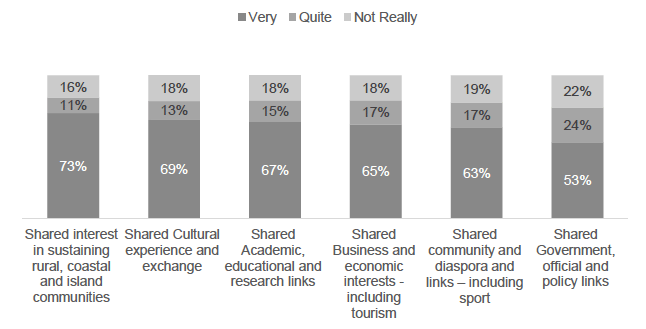
Sustaining rural, coastal and island communities was deemed the most important aspect of the relationship among both respondents based in Ireland (88%) and based in Scotland (69%). Cultural experience and exchange was seen as the second most important aspect with the second most selections as ‘very important’ from both sets of respondents (81% of those based in Ireland and 65% of those based in Scotland). Respondents thought that government, official and policy links were quite important but over a fifth thought they were not really important.
When asked how they view the relevance of the relationship in the coming five years, more than three-quarters of respondents viewed it as increasing in importance (see figure 5). That view was most strongly held among respondents based in Ireland at 92%, compared to 71% of those based in Scotland.

3.2 Respondents’ Interests in Economic Cooperation by Sector
When asked where they thought the relationship would expand economically, most respondents identified the tourism sector. Three-quarters (75%) of respondents based in Ireland and two-thirds (67%) of respondents based in Scotland thought that Tourism was the most likely sector to expand, the highest total for each country. Energy was next at 62% (71% for those based in Ireland and 59% for Scotland-based respondents). The sector identified by respondents as being least likely to expand was Finance, with a third of respondents identifying this as an area of expansion (see Figure 6 below).
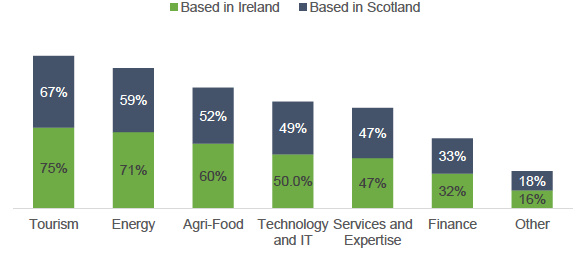
Respondents in each country were asked about the image of the other country in their own over the recent past (Figure 7). Nearly half of all respondents thought the image of the other country had improved. Just over half (51%) of Ireland based respondents thought the image of Scotland in Ireland had improved compared to 47% of Scotland based respondents who thought Ireland’s image in Scotland had improved. About a fifth of respondents thought that the other country’s image had deteriorated.
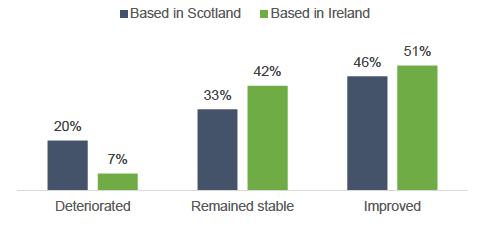
When asked what made the other country most visible in the country they are based in, there was a divide by location (see Figure 8). Scotland-based respondents said the most visible element of Ireland in Scotland was community and diaspora activity (61%). However, Ireland-based respondents said that sporting activity and events were the most visible element of Scotland in Ireland (64%). Over half of respondents in both countries thought cultural events and organisations were a visible element of the other country. Business and economic activities were viewed as the least visible element of presence in each country. It should be noted here that the vast majority of responses to the online engagement exercise were submitted by individuals, not by organisations (see section 2.2).
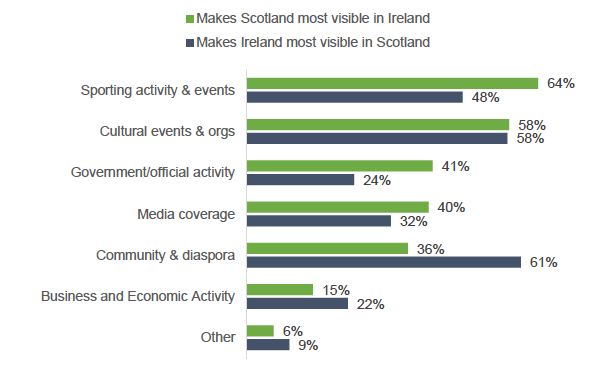
Individuals and organisations were asked to indicate how they engaged with the other country and trends appear to be similar between the Ireland-based and the Scotland-based samples. Those who answered the questionnaire as individuals were asked to select from a list of cultural and community-related options (Figure 9). Organisations and individuals were both invited to indicate what business, academic or official means of engaging with the other country they rely on (Figure 10).
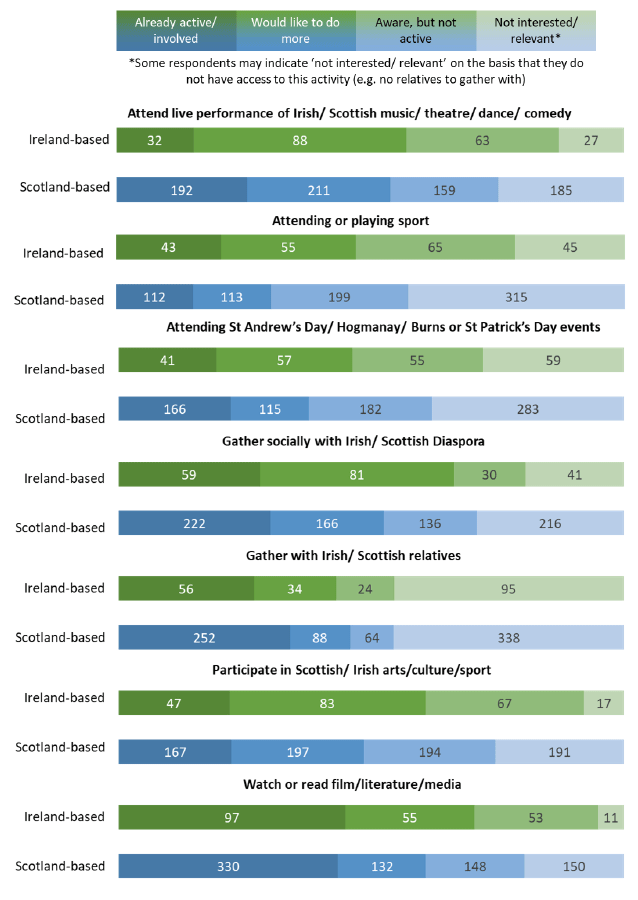
Of the 219 answers submitted by individuals based in Ireland (Figure 9), the most common way respondents engage with Scotland is by watching or reading film/ literature and engaging with media (97 responses, 44%). This was followed by gathering with the Scottish diaspora (59 responses, 27%) or Scottish relatives (56 responses, 26%). Only 32 individuals (15%) indicated they already attend live performances of Scottish music, theatre, dance and/or comedy, but 88 respondents (40%) would like to do this more often in the future, followed by 83 (38%) who would like to participate in Scottish arts/culture and sport.
A total of 779 individuals based in Scotland offered their views on the same question. Similarly to the Ireland-based sample, watching or reading film/literature and media is the most common way individuals use to engage with Ireland (330 responses, 42%), followed by gathering with the Irish diaspora (222 responses, 28%) or Irish relatives (252 responses, 32%). Only 112 (14%) already actively attend or play sport to engage with Ireland.
Organisations and individuals were also given the opportunity to indicate if they engage with the other country through academic, official, consumer or business routes (Figure 10 below). Eighty-two of the respondents based in Ireland are already engaging with Scotland as consumers of Scottish products and goods, followed by 51 respondents who get involved through connections with Scottish colleagues and counterparts and 48 through academic links. Involvement through investment/property seemed to be the least engaged option with 126 respondents indicating they were not interested or it was not relevant to them.
Looking at the Scotland-based sample, the trend is similar with 300 respondents already choosing Irish products and goods, followed by 142 respondents with active academic links and 102 with business links. Property and investment was not of interest to 496 respondents, and 434 respondents were not engaging with Ireland through official links through local or national government/agencies in Ireland.
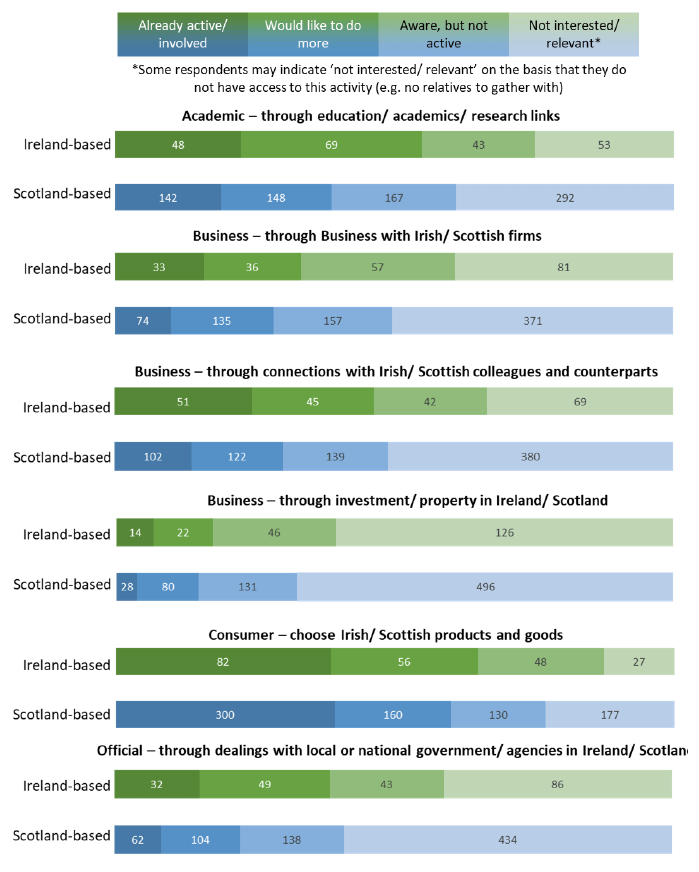
Contact
Email: socialresearch@gov.scot
There is a problem
Thanks for your feedback